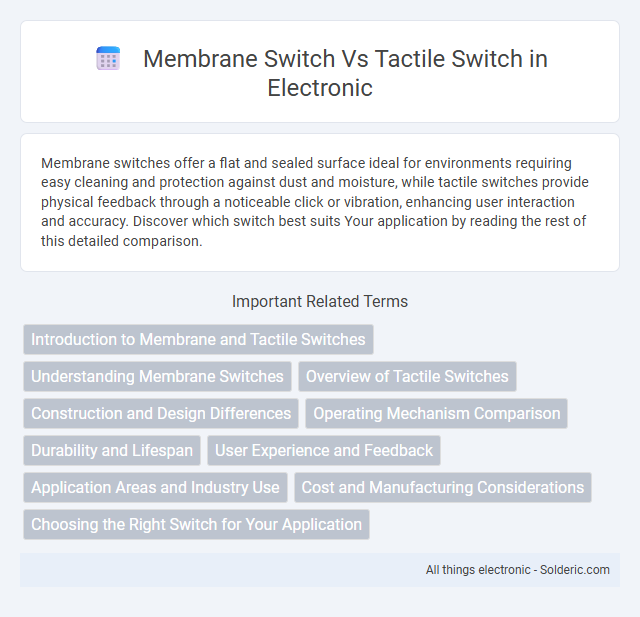Membrane switches offer a flat and sealed surface ideal for environments requiring easy cleaning and protection against dust and moisture, while tactile switches provide physical feedback through a noticeable click or vibration, enhancing user interaction and accuracy. Discover which switch best suits Your application by reading the rest of this detailed comparison.
Comparison Table
| Feature | Membrane Switch | Tactile Switch |
|---|---|---|
| Design | Thin layers with printed circuits and flexible overlays | Mechanical button with physical moving parts |
| Feedback | Soft, often no tactile feedback | Distinct tactile (click) feedback |
| Durability | High resistance to dust, moisture; lifespan up to 1 million cycles | Moderate; lifespan typically 100,000 to 1 million actuations |
| Application | Remote controls, medical devices, industrial equipment | Consumer electronics, keyboards, control panels |
| Cost | Generally lower price for high-volume production | Higher cost per unit due to mechanical parts |
| Customization | Highly customizable shapes and graphics | Limited customization; standard sizes mostly |
| Water Resistance | Excellent sealing; often waterproof | Limited water resistance; vulnerable to moisture |
Introduction to Membrane and Tactile Switches
Membrane switches consist of flexible layers that activate circuits when pressure is applied, offering a low-profile and cost-effective solution for user interfaces. Tactile switches provide distinct physical feedback through a momentary button mechanism, ensuring users can feel each activation clearly. Your choice between these switches impacts the durability, responsiveness, and user experience of electronic devices.
Understanding Membrane Switches
Membrane switches are thin, flexible layers of printed circuitry often used in control panels for their low profile and durability, making them ideal for applications requiring moisture resistance and dust protection. Unlike tactile switches which provide audible or physical feedback through mechanical components, membrane switches rely on pressure applied to their surface to complete an electrical circuit, offering a quieter and more customizable interface. Your choice between membrane and tactile switches depends on the need for feedback, environmental resilience, and design flexibility in your device.
Overview of Tactile Switches
Tactile switches provide distinct physical feedback through a noticeable click or snap when pressed, enhancing user experience by confirming actuation without visual cues. Unlike membrane switches, which rely on pressure-sensitive pads and typically lack tactile response, tactile switches use mechanical components such as metal domes or springs to generate immediate and reliable feedback. Your device benefits from the precise actuation and durability of tactile switches, making them ideal for applications requiring frequent and confident user input.
Construction and Design Differences
Membrane switches consist of flexible layers with printed circuitry separated by a spacer, creating a flat, sealed interface ideal for moisture resistance and compact designs. Tactile switches feature individual mechanical components, including a movable dome or plunger that provides physical feedback when pressed, resulting in a more tactile user experience. Your choice depends on the required durability, feedback sensitivity, and environmental conditions for the device.
Operating Mechanism Comparison
Membrane switches operate using pressure pads that complete an electrical circuit through a flexible, printed circuitry membrane, offering a low-profile and sealed design ideal for environments requiring moisture resistance. Tactile switches employ mechanical snaps to provide a distinct physical feedback by momentarily closing a circuit when pressed, ensuring reliable and precise actuation with a noticeable click sensation. The membrane switch's operation relies on pressure-induced contact without moving parts, while tactile switches depend on mechanical movement for tactile confirmation.
Durability and Lifespan
Membrane switches typically offer a lifespan ranging from one to five million actuations due to their sealed, flexible design that protects internal components from dust and moisture. Tactile switches, constructed with mechanical contacts, often provide a durability of 10 to 50 million actuations, delivering a more distinct tactile feedback and reliable performance under frequent use. The choice between membrane and tactile switches depends on the specific application requirements for durability, environmental resistance, and user feedback.
User Experience and Feedback
Membrane switches provide a soft, low-profile surface with minimal tactile feedback, making them suitable for environments requiring quiet operation but potentially less satisfying for users seeking clear input confirmation. Tactile switches deliver distinct physical feedback through a noticeable click or bump, enhancing user confidence and reducing input errors during repetitive tasks. The choice between the two directly impacts overall user experience, as tactile switches often improve accuracy and satisfaction, whereas membrane switches prioritize a sleek design and durability.
Application Areas and Industry Use
Membrane switches are widely used in applications requiring sealed interfaces such as medical devices, consumer electronics, and industrial control panels due to their durability and resistance to moisture and contaminants. Tactile switches are favored in electronics demanding precise feedback and reliability, including automotive controls, computer peripherals, and handheld devices. Your choice between membrane and tactile switches should consider the specific environmental conditions and user interaction needs of your industry application.
Cost and Manufacturing Considerations
Membrane switches offer lower manufacturing costs due to simpler materials and assembly processes, often using printed circuits and flexible substrates. Tactile switches generally incur higher expenses because of their mechanical components and more complex assembly requirements. Choosing between these switches depends on budget constraints and production volume, with membrane switches favored for cost-effective mass production.
Choosing the Right Switch for Your Application
Choosing the right switch depends on your application's requirements for durability, feedback, and design flexibility. Membrane switches offer a slim profile, waterproof capabilities, and custom graphic overlays ideal for environments needing easy cleaning, while tactile switches provide distinct tactile feedback and are preferred for applications requiring precise, physical button presses. Evaluating factors like usage frequency, environmental exposure, and user experience will help determine whether a membrane or tactile switch best suits your needs.
membrane switch vs tactile switch Infographic

 solderic.com
solderic.com